As mentioned in our 5 common causes of sciatica post, one of the most common conditions that may cause symptoms of sciatica is spondylolisthesis. Spondylolisthesis is a treatable medical condition that occurs in as many as 200,000 people in the United States per year. It may occur anywhere in the spine but is usually isolated to the neck (cervical spondylolisthesis) or the low back (lumbar spondylolisthesis). Since we are discussing a common cause of sciatica, we will stick to discussing lumbar spondylolisthesis in this post.
Note that this condition responds well to physical therapy, but it is imperative that you seek medical advice if you have spondylolisthesis.
What is Lumbar Spondylolisthesis?
This condition is the result of one vertebra slipping out of place in relation to the vertebral body below it. It usually slips forward, which is known as anterolisthesis, but may also slip backward (retrolisthesis) or even rotate.
Spondylolisthesis can also be a precursor to spinal stenosis: as the spine attempts to stabilize the affected spinal segment, the facet joints enlarge and place pressure on the nerve root, causing spinal stenosis.
Diagnosing Spondylolisthesis
To accurately diagnose spondylolisthesis in the lumbar spine, one needs to have specific X-rays. As mentioned in our post on piriformis syndrome, consulting with a healthcare professional or spinal specialist is the first step.
Spondylolisthesis is graded by the severity of the slipping. See the image below:

Spondylolisthesis occurs when there is a defect or fracture in the bony part in the posterior or back part of the vertebra, called the Lamina:
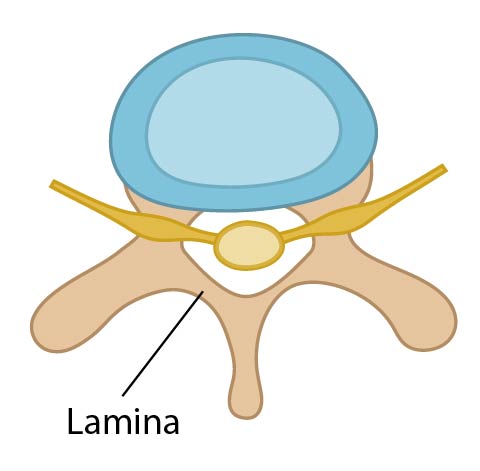
It is important to discover the underlying causes of spondylolisthesis. As well as risk factors that may increase a one’s chances for developing or worsening of spondylolisthesis
What are the types of spondylolisthesis?
Types of spondylolisthesis include:
- Degenerative spondylolisthesis, the most common type, happens due to aging. Over time, the disks that cushion the vertebrae lose water. As the disks thin, they are more likely to slip out of place.
- Isthmic spondylolisthesis happens as a result of spondylolysis. The crack or fracture weakens the bone.
- Congenital spondylolisthesis occurs when a baby’s spine doesn’t form the way it should before birth. The misaligned vertebrae put the person at risk for slippage later in life.
Less common types of spondylolisthesis include:
- Traumatic spondylolisthesis happens when an injury causes vertebrae to slip.
- Pathological spondylolisthesis occurs when a disease — such as osteoporosis — or tumor causes the condition.
- Post-surgical spondylolisthesis is slippage as a result of surgical treatment.
Spondylolisthesis Symptoms
Individuals can have this condition with no symptoms, or the symptoms may be debilitating and very serious. Symptoms of spondylolisthesis include:
- Lower back pain
- Stiffness in the back
- Localized pain or tenderness in the back just above the pelvis
- Tight hamstrings
- Pain in the thighs and legs (radiculopathy)
- Pain in the buttocks
Spondylolisthesis Treatment: What Can You Do?
There are many nonsurgical treatments for spondylolisthesis. The first thing one needs to do is to get an accurate diagnosis. There is a specific X-ray to discover spondylolisthesis, or an MRI may be useful. Then correlating your symptoms with the diagnosis is important.
There is a direct correlation between the level of instability of one’s spine and the severity of symptoms in the presence of spondylolisthesis.
Most of the time you can manage this condition by maintaining a healthy, strong and stable spine through exercise, maintaining a healthy body weight, watching your posture at work and while sleeping. Additionally, observing safe ergonomics when lifting and performing activities of daily living will help to protect your back.
More severe cases may require aggressive management including spinal injections. In some extreme cases, a spinal fusion surgery may be necessary.
Spondylolisthesis Exercises
The following exercises should relieve some of your pain and should not reproduce your pain (details below):
- Hamstring stretches
- Gastrocnemius stretches
- Pelvic tilts
- Abd stabs with marching
- Pelvic tilt with single knee to chest
If pain gets worse during the course of exercise, we recommend you stop and consult the medical provider you’re working with.
Though the exercises are designed to minimize the mechanical stress on the tissue involved in spondylolisthesis. They are not a substitute for a comprehensive assessment and management plan for your condition. Please see your therapist or doctor with questions .
Hamstring Stretch
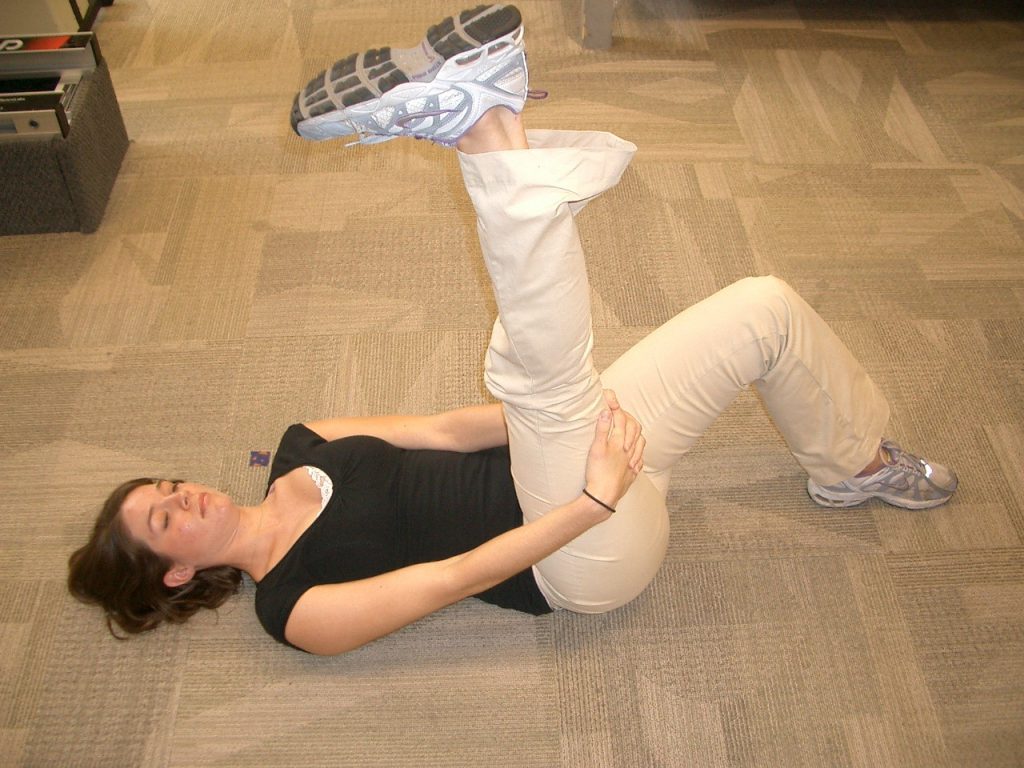
Start by lying flat on the floor (or table) on your back. Place your hands behind your knee. Extend your leg in the air and point your toe backwards towards yourself. Hold for 30 seconds. Lower your leg slowly and repeat for 2-3 repetitions per leg.
Gastrocnemius Stretch
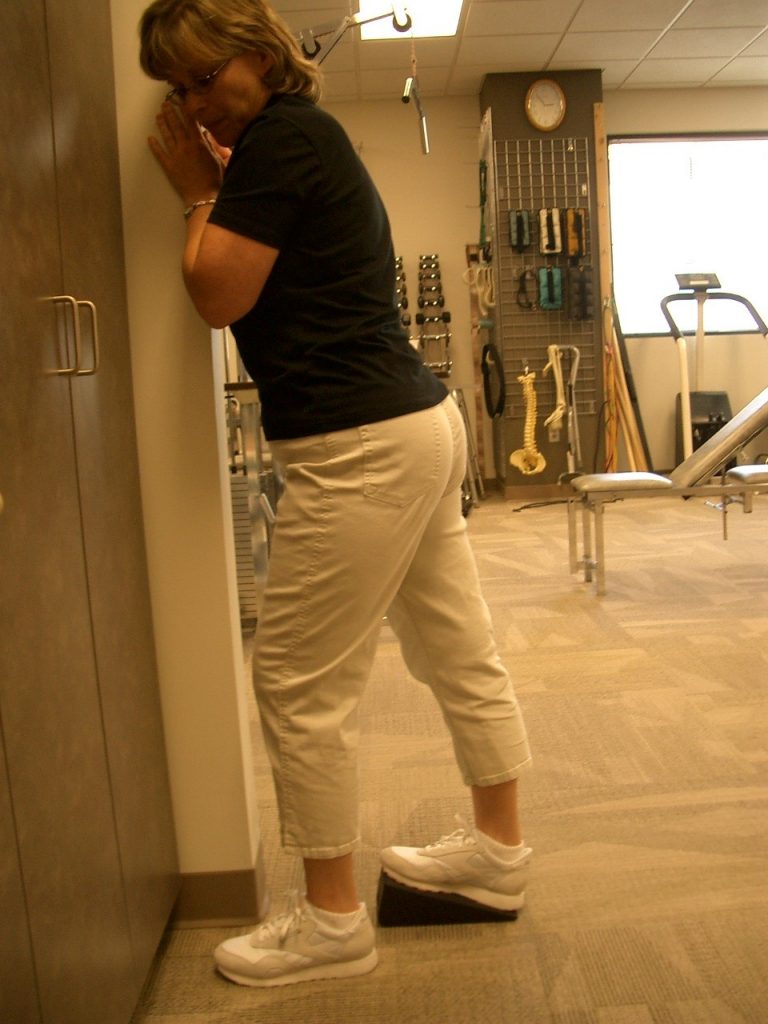
Use a wedge or towel and place your foot on top. After placing your opposite leg forward of the wedge, lean forward until you feel a stretch in your calf muscle. Keep the rear leg straight. Hold for 30 seconds and repeat for 2-3 repetitions per leg.
Pelvic Tilts
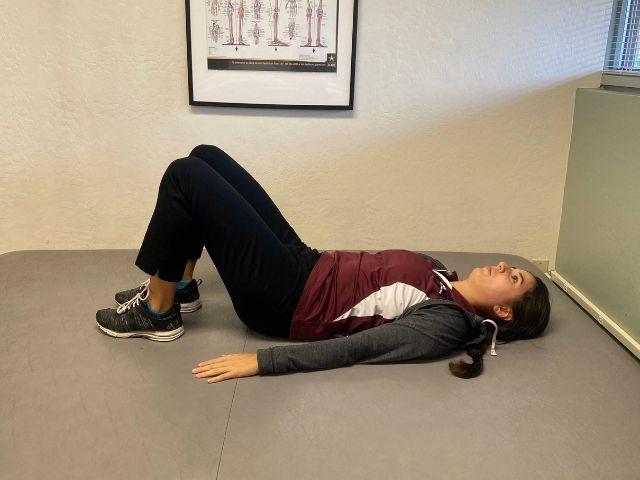
The start position for pelvic tilts is lying supine with knees bent and your arms by your sides. Gently rock the pelvis forward bringing your tailbone towards the mat. Next, roll the pelvis backwards by trying to pull your belly button down towards your spine. This will bring the tailbone towards the ceiling. Hold for three to five seconds at each end. Repeat 10 times. Do two sets, once or twice a day.
Ab Stabilization with Marching
Lie on your back with your knees bent and place your hands on your lower abdominals in order to feel the muscles working. Tighten the abdominals and press the low back to the mat. This is the setup position for the exercise.
While holding this position, march the legs alternating four times. Do not allow your low back to lifto off of the mat. Repeat for 10-15 repetitions and complete 2-3 sets per day.
Pelvic Tilt with Single Knee to Chest
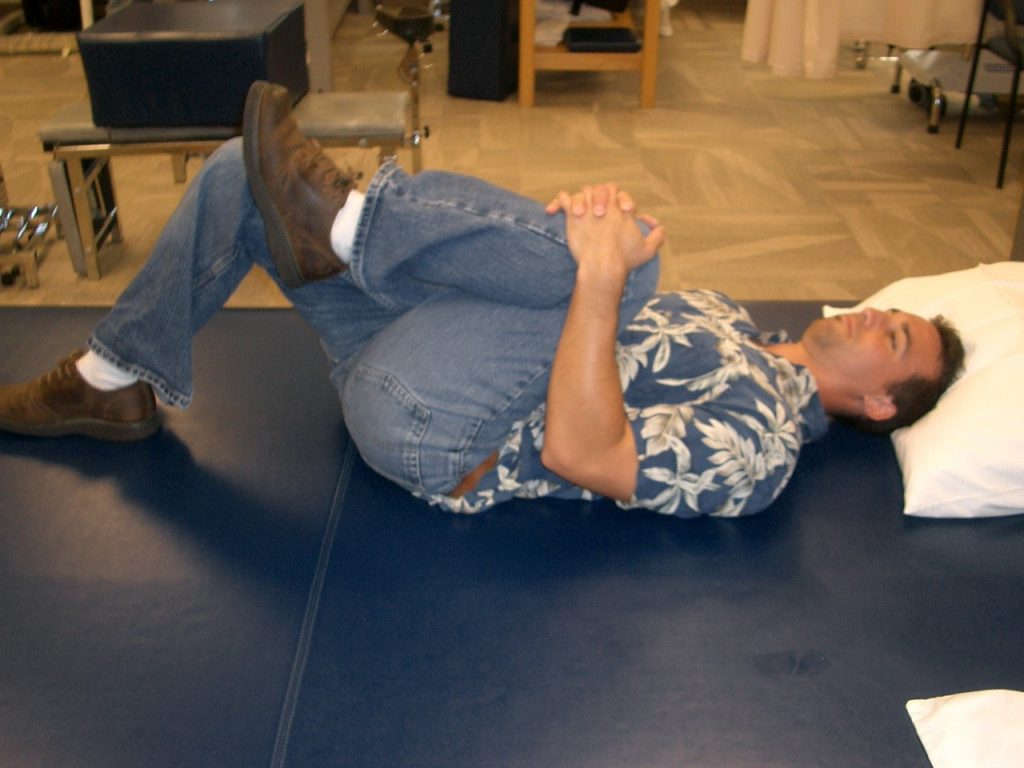
Perform a pelvic tilt as described above. Place your hands in front of one knee. Gently pull your knee towards your chest. Hold for 30 seconds, and then switch sides. Repeat for 2-3 repetitions per side.
Next Steps
As with any bone fracture, expect at least 4-8 weeks to make a recovery. However, it can take longer. As mentioned above, recovery from spondylolisthesis is possible, but it’s not recommended to try and heal this one on your own – consult with a spinal specialist and then find a good physical therapist in your area who can help you track your progress. If you live anywhere in the Phoenix, Arizona area, feel free to reach out to us for a free consultation or to schedule an evaluation.

















